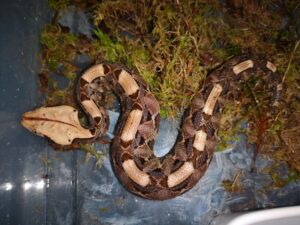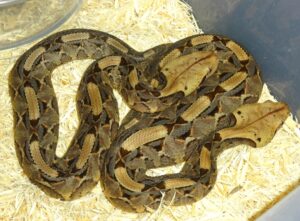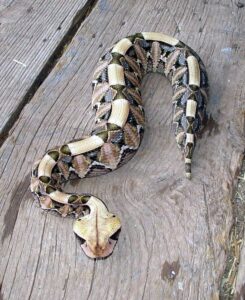As the name suggests, the West African Gaboon viper is a viper species endemic to West Africa. Two large horn-like scales above its nostrils distinguish it from the closely related Gaboon viper. It has the longest fangs of all venomous snakes, measuring 2 inches in length! It is also the largest of all true viper species in the world.
Scientific Classifications
- Suborder:Serpentes
- Family:Viperidae
- Genus:Bitis
- Species:B. rhinoceros
Conservation Status
Description
Size
They can get as long as 6.5 ft (2 m) and often weigh over 40 pounds. The average length is 4 ft (1.2 m).
Color and Appearance
What makes the viper unique is a set of enlarged nasal scales resembling a pair of horns on its nose. The triangular head has a single dark triangular marking extending from the eye to the angle of the mouth. The color of the ridged scales ranges from brown to purple. The detailed symmetrical pattern along its body looks like a line of yellow hourglasses.
Are They Dangerous to Humans
Though venomous, the surprisingly calm snakes rarely bite, even when stepped upon. When disturbed, they startle their enemies with a series of long, drawn-out hisses.
The potent venom of the West African Gaboon viper is predominantly cytotoxic. Bite symptoms may include severe pain, shock, blistering, swelling, and necrosis. Polyvalent antivenom can effectively treat a bite.
West African Gaboon Vipers at a Glance
Distribution
In West Africa, it ranges from Togo to Guinea and possibly Guinea-Bissau through the intervening countries of Ivory Coast, Ghana, Sierra Leone, and Liberia.
Habitat
It lives in savannas, woodlands, and humid forests. Though mainly nocturnal, the snake loves basking on the forest fringes.
Lifespan
It lives for around 20 years.
Predators
There are no known predators of these vipers. It is because their beautiful color helps them effectively camouflage as they sunbathe, half-buried in the forest floor debris, or on any other occasion.
Diet
The West African Gaboon viper mainly eats rodents, small mammals, toads, frogs, and ground-dwelling birds. It uses its fangs to inject venom to immobilize its prey.
Reproduction
Ovoviviparous (gives birth to live young from eggs that hatch inside the body)
A female gives birth to 50-60 babies in a litter. The young are self-dependent from birth.
Source
pbs.twimg.com, i.pinimg.com, strictlyreptiles.tv








